Published: Paola Velasco and artwork by Ryan Ward.
Promoting common interest in sustainable development and environmental problems would be more effective if solutions resulted in all stakeholders being better off. However, this is rarely the case since strategies to reduce greenhouse gas emissions usually result in winners and losers (WCED, 1987), and renewable energy technologies (RETs) have not proven to be the exception. The adoption of ambitious renewable energy targets has had profound social, economic, and environmental implications that operate at scales ranging from local to global and has raised questions about social justice in capitalist societies. Therefore, identifying key social justice issues related to energy has become hugely important in advancing the proliferation of clean energy.
Wind power has largely improved from a technical point of view, becoming a relatively cheap and exploitable renewable resource that is now at the core of many strategies for climate change and the energy transition. It has been successfully implemented mainly in Asia (203,643 MW), Europe (161,330 MW), and North America (97,611 MW), becoming the world’s fastest-growing source of power generation in the last decade, and growing at 8 per cent to reach 486,749 MW in 2016 (GWEC 2016). Nevertheless, its development has been marked by local social opposition that can be found in developed and developing countries alike.
One example of adverse social implications is the development of wind energy in indigenous communities in Southern Mexico. Given the saturation of the energy markets in developed countries, the wind energy industry has turned their attention to emerging economies with significant wind resources. Mexico is considered to be an ideal location for large scale wind energy production, particularly the Isthmus of Tehuantepec, a region that has been identified as one of the best areas in the world to establish wind farms. The average wind speed exceeds 10 m/s, while in the world 6.5 m/s is the average for energy generation. Moreover, wind in the Isthmus of Tehuantepec is relatively stable, with a high percentage of wind hours per year, marking its energy potential standing as excellent.
Following a major energy reform in 2008 that facilitated international private capital investments, large international utility companies started to operate in the region, producing up to 3,527MW in 2016. Nevertheless, these installations have faced levels of local social opposition. For instance, in 2012, a 396MW development that was planned to be the largest in Latin America was cancelled due to conflicts linked to land speculation and ethnic tensions between Zapotecs and Huaves. This caused an approximate loss of $7 million for the main investors (the global investment bank Macquarie, based in Australia, Mitsubishi Corporation, and Dutch pension investment group PGGM). While the establishment of wind farms was a good opportunity for the region in theory, the lack of social acceptance put further investments and the well-being of the local population at risk.
One main concern raised by indigenous communities in the region is the unequal distribution of benefits and ills derived from wind energy developments. The Isthmus of Tehuantepec crosses the state of Oaxaca, a region shaped by an indigenous identity in the legacy of colonialism, with high levels of poverty. 56% of the Oaxaca population consider themselves indigenous, and it is one of three states with the highest indigenous population percentage in Mexico (INEGI 2015). It is also one of the most marginalised. 84% of the municipalities face a ‘moderate’, ‘high’ or ‘very high’ grade of marginalisation, according to the National Population Council’s (2015) marginalisation index, which considers deficiencies in basic education and housing, residence in small, dispersed and isolated localities, and low monetary income.
Given the poverty situation, communities initially welcomed wind energy developments as a way of generating external income paid through land lease agreements and employment. However, members of the community argue that contrary to their initial expectations, only a small fraction of the population has benefited economically, resulting in the emergence of social inequalities that did not exist before the establishment of wind farms in the region. For instance, only 6.2% of the population has been a creditor to a land lease and 1.6% has a job in the local wind energy industry.
Furthermore, wind energy developers in the region are not formally obliged to provide benefits to local communities. The lack of institutionalisation of benefit-sharing has led to the development of corporate practices that are implemented on an ad hoc basis and at the developer’s discretion. Consequently, developers view their contributions as altruistic, not as part of indigenous communities’ right to profit from their land and resources. Often, developers only offer benefits in exchange for acceptance of new windfarms or enlargement of existing ones. Moreover, these benefits are only received by a few, yet ills are spread throughout the region. Environmental impacts on the local wildlife – particularly birds and bats – as well as noise pollution, are felt by similarly by everyone within neighbouring communities. Thus, this unequal distribution of benefits and ills has caused a number of local conflicts that ultimately derive from different levels of resistance to new wind energy developments.
Thus, this unequal distribution of benefits and ills has caused a number of local conflicts that ultimately derive from different levels of resistance to new wind energy developments.
Therefore, the development of wind energy infrastructure in Mexico has demonstrated that sustainable solutions are not necessarily paired with socially equitable outcomes. For development to sustainably evolve to tackle inequalities, adequate bottom-up processes to establish a more equal distribution of benefits and ills should be put in place. This is the holy grail of all development activities, and renewable energy projects are no exception. This is easier said than done, and the quest for the tools to make this happen in practice continues, well beyond the Isthmus of Tehuantepec.



